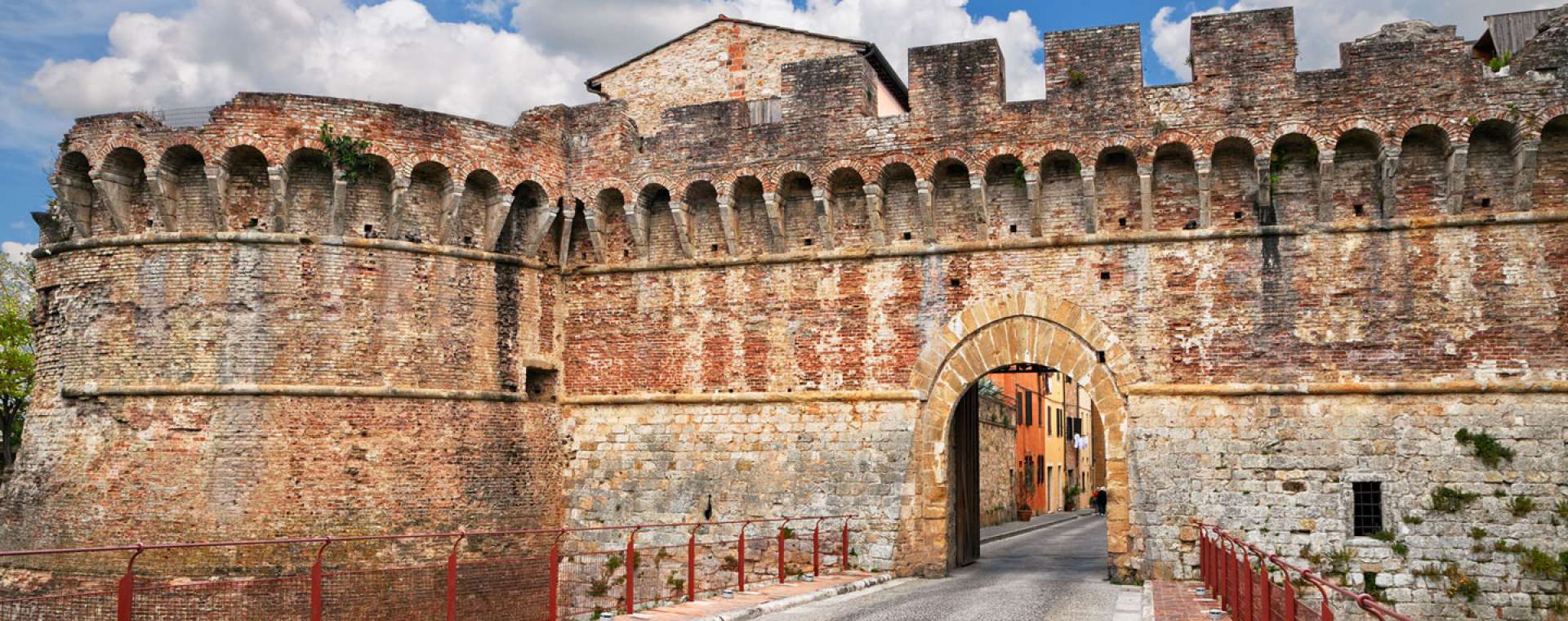The main claim to fame of Colle di Val d’Elsa, 9 miles south-east of San Gimignano, is as the birthplace of architect Arnolfo di Cambio. Born around 1245, Arnolfo built Florence’s Palazzo Vecchio, started work on its massive cathedral and had a hand in several other Gothic buildings around Tuscany, Umbria and Lazio, before his death sometime in the early 1300s.
The town is clearly divided between Colle Alta (“High Colle”) — the original medieval buildings — and newer Colle Bassa (“Low Colle”), strung around the base of Colle Alta’s long-inhabited rocky outcrop. A transparent lift runs between the two, via an ancient tunnel through the rock.
In the Beginning...
Arnolfo’s (probable) birthplace is still standing. It’s said to be the Torre di Arnolfo, in the oldest part of Colle Alta, the Castello neighbourhood — now a tiny, tight-packed cluster of medieval lanes. The simplest way into Castello crosses the bridge from Borgo Santa Caterina (once a separate village, now joined to Colle Alta) and through a gate built into the Palazzo Campana (1539).
A couple of decades after Arnolfo’s birth, Colle Alta provided refuge for locals during the 1269 Battle of Colle Val d’Elsa. A small Guelph army holed up here defeated Siena’s massed Ghibelline forces, revenge for a catastrophic Florentine/Guelph defeat at Montaperti 9 years earlier.
Colle has a long tradition of craftsmanship, and was nicknamed Città di Cristallo (“city of crystal”) for its many glassworks
Visit This
Also in Colle Alta is Santa Maria in Canonica, an intimate, single-nave church that dates at least to 1184. A golden Gothic panel, complete with intact predella, by Pier Francesco Fiorentino stands on its simple altar.
Colle’s nearby Duomo is a total contrast: light and airy, with tall interior arcades and a high altar Crucifix by Mannerist sculptor Giambologna and his assistant, Pietro Tacca.
The archaeological collection at Colle’s Museo Archeologico Bandinelli is slightly lower-key, but has Etruscan finds from the area, including some of the most significant tomb discoveries in Tuscany.
In 2017, the Museo di San Pietro reopened after a 2-decade closure. Its revamped collection tells the story of the town’s turbulent history, spiritual traditions and artisan heritage.
The architectural highlight of Colle Bassa is an extraordinary red-steel structure by Giovanni Michelucci. This branch of Monte dei Paschi di Siena bank was built over the site of a woollen mill. (Michelucci is probably best known as the architect of Florence’s modernist Santa Maria Novella railway station.)
Out of Town: Certaldo
Certaldo, 14 miles north-west of Colle, is best known as the home (for some of his life) of Giovanni Boccaccio (1313–75). The “Tuscan Chaucer” is best known for “The Decameron”, a collection of stories still read today as an example of medieval humour, allegorical storytelling and the simple joy of a good yarn. Alongside Dante and Petrarch, Boccaccio completes a trio of great Tuscan early writers.
His former home (probably), the Casa del Boccaccio, is preserved as a museum and study centre dedicated to Boccaccio’s life and writings.
Buy This
Colle has a long tradition of craftsmanship. It was nicknamed Città di Cristallo (“city of crystal”) for its many glassworks, and is still a major source of Italian crystal (glass mixed with lead oxide). Installed in an abandoned underground furnace from the 18th century, the Museo del Cristallo recounts Colle’s glassmaking history via a host of close-up and tactile exhibits.
One of Tuscany’s best contemporary ceramics workshops is in Colle Alta: Manufactum. Everything on the shelves — crockery, tiles, condiment pots, jugs, and more — is hand-thrown and crafted on the premises.
Three Excursions from Colle Val d’Elsa
- Monteriggioni: its perfect ring of medieval walls and towers got a mention in Dante’s “Inferno”, and they’re still standing
- San Gimignano: another preserved medieval town, with hidden alleys, Gothic towers and Renaissance frescoes, plus one of Tuscany’s great ice-cream artisans
- Castellina in Chianti: the unofficial capital of the Sienese Chianti was fortified by Florentines — like Colle — and has a surviving Etruscan burial mound and an underground street you can walk along
